|
Click pictures for a larger version.
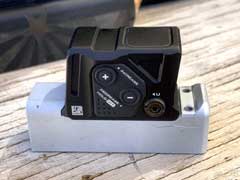
COA optic shown on sample mount.
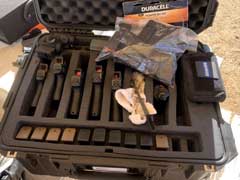
Wayne Dobbs, of Aimpoint, brought along a case of COA
sample pistols for shooters to try different model Glocks.
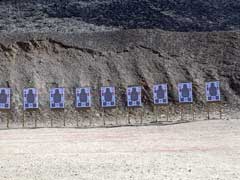
The array of USCCA Defensive Pistol Program targets
used by the shooters for the event.

USCCA instructor Freddie Blish providing a refresh of
the 4 Firearms Safety Rules before the class.

Instructor Jim Owens (R) beginning his lecture on the
benefits of a 25-yard zero.
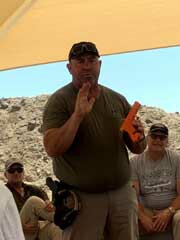
Jim Owens providing guidance on how to build a proper
grip.
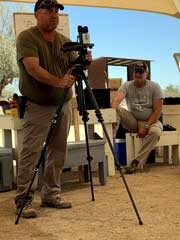
Jim Owens demonstrating his personal setup for a
25-yard zero using a Manfrotto tripod and a Ransom Rest Multi
Caliber Steady Rest.

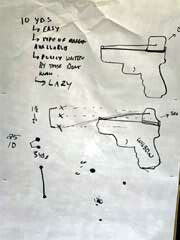
Jim Owens illustrating the differences between
various zeroing distances and the benefit of a 25-yard zero.
|
|
Aimpoint is no stranger to the American shooter. They invented the reflect sights and perfected red dot optics over the last 30 or so years. Initially developed as a hunting sight in Europe (think running wild boars!), the step change in their consumer market started around 1996-1997 when their COMP M2 was adopted by the US Military, followed by the COMP M4 in 2002-2004. With many other fantastic carbine optics, including the Patrol Rifle Optic, the Duty RDS, and the Aimpoint Carbine Optics, a next, big, step, especially for the handgun shooter, was the Advanced Compact Reflex Optics (ACRO) family of enclosed emitter sights allowing for a more robust sight with enhanced protection against the environment when compared to the open emitter models. Water, snow, mud, lint, and food debris do have a tendency to accumulate inside the lens of open emitter sights, not so with the enclosed emitters.
Introduced at SHOT Show in 2025, the new enclosed emitter Aimpoint COA red dot optic was designed for concealed carry pistols and is the next generation of pistol mounted optics. This miniaturized red dot optic is designed to be direct mounted using a proprietary cut, called the A-cut, allowing the housing to be snapped in place on its locking lugs, and then locking in the back with a screwed in wedge which also serves as a backup iron rear sight. Being directly mounted to the slide, the optic sits lower in the slide itself, not only resulting in the ability to use standard height sights, but also resulting in a smaller mechanical offset for point of impact to point of aim. In fact, almost all pistols shot in the class showed an offset of only about 3/4" at 3-5 yards. Another benefit is that the lower mounted optic helps shooters see their dot a little more easily and quickly.
The most noticeable exterior feature is the significantly reduced housing surrounding the glass lenses when compared to its ACRO P2 predecessor. While the lens size remains the same, the slimline housing surrounding the COA provides the eye with the appearance of a larger window. It's quite surprising to compare the two optics next to each other and see how much bigger the COA window appears to the eye. the mind sure knows how to play tricks on us!
With Aimpoint's state of the art technology, the LED emitter emits a perfectly round dot with no mechanically induced distortion. In fact, Wayne Dobbs, Aimpoint's Western US representative, further stated that the easiest way to check that is to use your mobile phone and take a picture of the dot in the housing, it will be perfectly round. Any distortion seen is due to the shooter's eye and not the dot itself. Another, less noticeable to the user, feature is that this is the first optic sight where the sight adjustments actually move the inner tube LED emitter directly, instead of moving the outer tube around the emitter inner tube, further improving the reliability of the sight adjustments. Using the highest quality European glass, the COA's clarity is world class and far superior to its competitors, foreign and domestic. This is most evident when looking at the edges of the glass and testing for parallax.
With the project itself starting about 3 years ago, and leveraging a prior existing relationship with the ACRO P2, the COA was introduced in a partnership with Glock in a one-year exclusivity agreement. As of this writing (July 2025), the optic is not available separately, it is only available on Glock models 43X, 48, 45, 19 and 47 9mm pistols. While Aimpoint has been working feverishly to supply COA sights to Glock, I know that availability of guns from Glock has been limited since launch. Local firearm dealers here in the Phoenix, AZ area tell me that these COA equipped Glock pistols are some of the hardest guns to get from distributors across the country and that, once in stock, they tend to sell very quickly. This speaks to the already strong interest from consumers for a great, reliable and proven service pistol combined with a trusted and well established pistol mounted red dot sight.
I recently had an opportunity to attend a 3-day training class focused solely on the Glock pistols equipped with COA pistols. The class, hosted by Freddie Blish and Jim Owens, both long time established instructors with experience in the US Military and Law Enforcement, as well as Gunsite and USCCA instructors, was held in conjunction with the USCCA and their new Defensive Pistol Program (DPP). The first day of the class was spent learning about the Aimpoint COA, how best to zero it, and getting familiar with the pistols. Some of the students' first experience with the pistol was on that first day so taking some time to familiarize themselves with the optic proved very valuable.
One of the most important steps to a pleasant, and responsible, shooting experience, whether with iron sights or pistol mounted optics, is a proper zero. On the first day, Jim Owens provided some basic instructions and process for zeroing. Jim is a firm proponent of a 25-yard zero and, in fact, has developed his own tripod zeroing device using a Ransom Rest Multi-Caliber rest mounted on a Manfrotto tripod. This gives a very sturdy, stable, yet adjustable, platform for holding the pistol steady and made zeroing the pistols a fairly simple task. Of course, it helps when the Glock pistols are already zeroed at the factory, a nice feature, as three pistols that we checked for zero early before the first day were already zeroed almost perfectly at 25-yards!
The benefits of a 25-yard zero is that 1) at ranges under 25 yards, rounds will impact on, or slightly lower than, point of aim, and 2), most importantly, at ranges from 25-100 yards, the rounds will also impact lower than point of aim, down to 6-8 inches at 100 yards. A 15-yard zero will give similar performance at distances under 15 yards, but will begin to impact higher than point of aim at 25 yards, and will actually impact over the target at 100 yards. When all shooters are accountable for every round fired and sent down range, knowing the performance of the 25-yard zero helps provide increased assurance that, with a good sight picture and trigger press, there is much lower risk of sending a round over your target.
Once the pistols zeroed, and all shooters familiarized, we began to run drills for the next two and a half days following the USCCA Defensive Pistol Program (DPP). The labor of love of Steve Hendricks at USCCA, this is relatively new program introduced last year. In fact, I had the pleasure of being one of the very first students through the program in its very first course offered last year. DPP focuses on concealed carry and drills are to be done from concealment.
So, how did the pistols and optics perform? Well, the pistols performed flawlessly, as expected from Glock pistols. Glock has been making pistols for over 40 years and have perfected their service pistols. My personal Glock model 45 just ran like a sowing machine and was utterly reliable. The Aimpoint red dot COA sights all performed just as reliably as the pistols on which they were mounted. There were no failures, no zero shifts, no adjustments issues, no brightness or dimming issues experienced throughout the three days by any of the students. I checked my 25-yard zero after a full day of shooting and manipulating the pistol, and there was absolutely no zero shift detected.
We did experience that, on most of the guns, the screws that hold the rear sight wedge were slightly loose after the first day of shooting. It was an easy problem to resolve with Fix-It Sticks, and all sight wedges were tightly secured at the factory prescribed
18-ft-lbs of torque. What was interesting is that I checked the same wedge screws after shooting another 400 rounds, or so, on the second day and the screws were still nice and snug. We did have one shooter who had one of the screws on his brand new Glock 19 COA pistol that was about 1/2 to 3/4 of a turn loose out of the box. While it is probably an anomaly, as they are specified to be torqued at Glock, I would recommend that those screws be checked before zeroing your pistol, just to avoid potential frustration.
Personally, I thoroughly enjoyed shooting my Glock 45 with the Aimpoint COA. Having other handguns with the ACRO P2 red dot on them, the thinner housing on the COA really made a big difference and made the window feel bigger to the eye. Combined with the low mounting on the slide, reliably and quickly acquiring the dot was no real difficulty. I have already decided to spend more time with it, and will take some more training classes. I also think a Glock 48 sized pistol with the COA is in my future and will make for a wonderful, reliable, concealed carry option.
PLEASE NOTE: this article was written prior to Glock's announcement of temporarily discontinuing COA pistols for sale to the civilian market and focusing on law enforcement sales until supply of the COA from Aimpoint catches up to their back orders.
Matt
Olivier
  
Got something to say about this article?
Want to agree (or disagree) with it? Click the following link to
go to the GUNBlast Feedback Page.
|
|
Click pictures for a larger version.
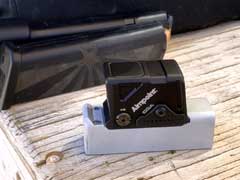
COA optic shown on demo mount.
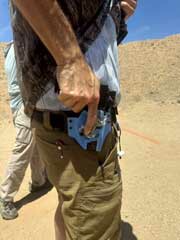
Author drawing his Glock 45 with COA optic.
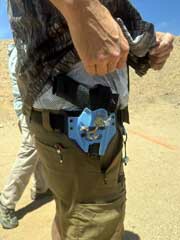
Author’s Glock 45 with COA optic. Matt’s
gun was slightly modified with a grip reduction by Henry at
Robar Customs LLC in Peoria, AZ and Glock Performance trigger
installed by Fink’s Custom Gunsmithing in Paulden, AZ.

Wayne Dobbs, of Aimpoint, providing details behind
the superior features of the COA optic.
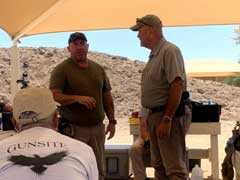
Jim Owens and Wayne Dobbs engaging in the benefits of
an enclosed emitter optic.
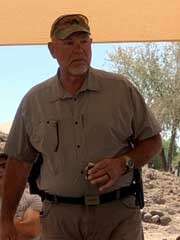
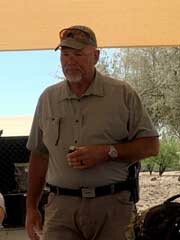
Wayne Dobbs, retired southern lawman, and Brother
Shootist, reacts to a question about a competitor’s optics.

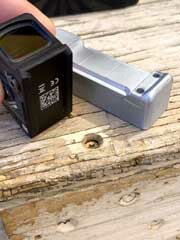
Demo mount showing the innovative and proprietary
mount of the COA optic.
|
![]()